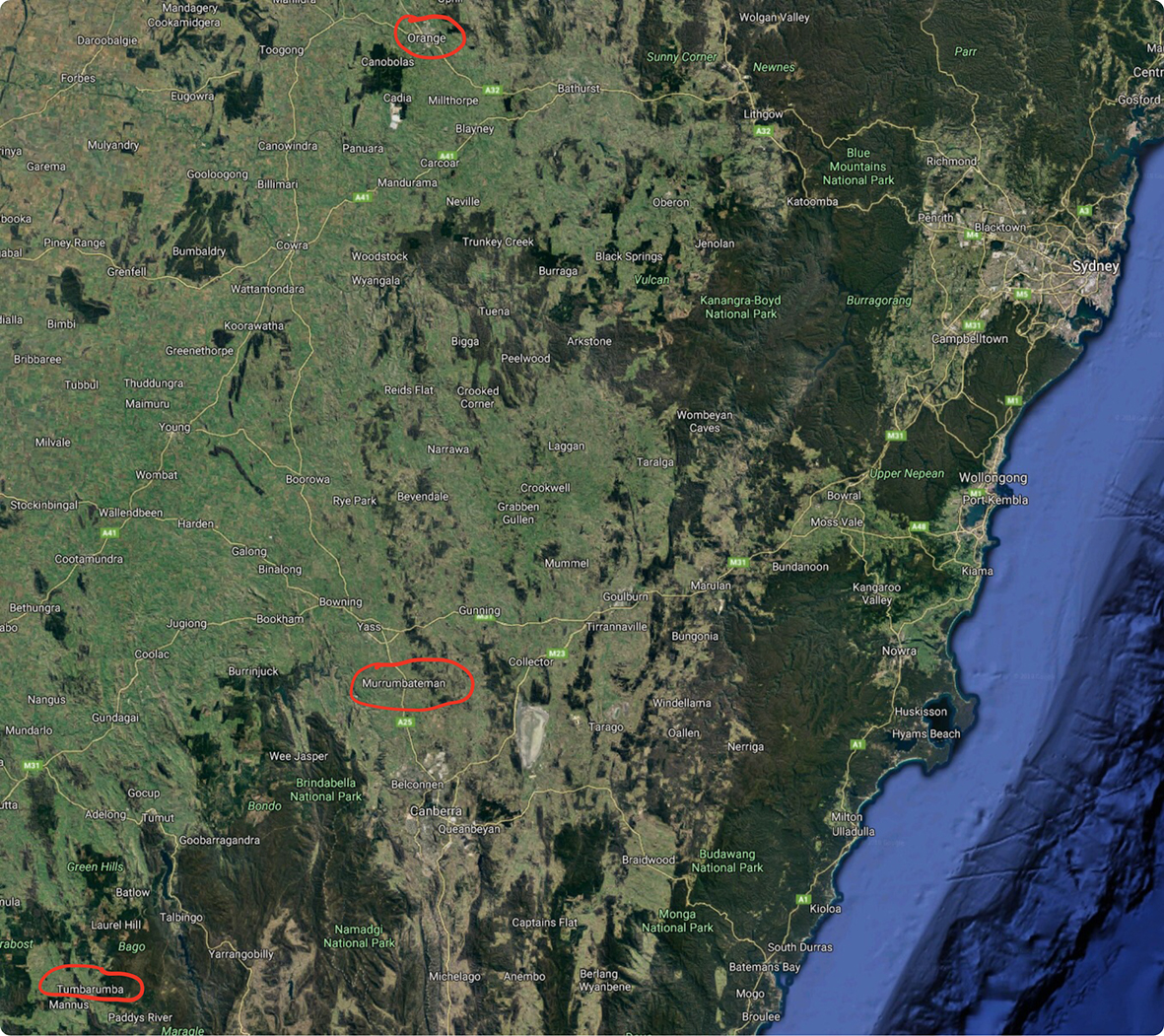Ken Helm grows grapes and makes wine at Murrumbateman in the Canberra District. He also sources riesling grapes from neighbouring regions of the New South Wales high country on the western slopes of the Great Dividing Range.
In the 2017 vintage, working from a new, dedicated riesling cellar, Helm produced three rieslings from the Canberra District and one each from Tumbarumba and Orange.
‘Murrumbateman’s the centre of the universe’, reckons Helm. Hence, I took great trouble to locate his village in the middle of the map below. Tumbarumba lies 130km to the southwest of Murrumbateman, while Orange is 190km to its north.
The three sites share a continental climate – amplified by altitudes between 600 and 700 metres – resulting in warm days and cool nights during the autumn ripening period. In these conditions, the late-ripening riesling grape develops clear varietal character while retaining fresh acidity.
The wines present subtle variations of riesling, driven largely by minor differences in growing and ripening temperatures of the sites.

![]() Helm Tumbarumba Riesling 2017 $30 (sold out)
Helm Tumbarumba Riesling 2017 $30 (sold out)
The grapes come from Juliette Cullen’s Tumbarumba vineyard at 620-metres altitude. The site’s cooler and wetter than Helm’s at Murrumbateman and probably explains the apple- and pear-like character widening the spectrum of the usual floral and citrus nature of riesling. The shimmering fresh palate finishes bone dry, with scintillating acidity.
![]() Helm Orange Region Riesling 2017 $30
Helm Orange Region Riesling 2017 $30
Although Orange lies 190km to the north of Murrumbateman, growing temperatures are lower, influenced by cool air flowing from Mount Canobolas, the seminal landmark of the region, and the 700m altitude of the vineyard. The wine presents Granny Smith apple-like characters, cut with tangy lime-like acidity and flavour. It’s bone-dry and taut as a high wire.
![]() Helm Canberra District Classic Dry Riesling 2017 $38
Helm Canberra District Classic Dry Riesling 2017 $38
Helm’s original riesling, now in its fifth decade of production, presents a tangy, lemony side of riesling with notably rounder, fuller palate than the more austere wines from Tumbarumba and Orange. That extra body and up-front fruitiness mean absolutely delicious drinking now. But naturally high acidity and a decades-long track record mean you can cellar this wine for ten years or more and enjoy its flavour evolution along the way.
![]() Helm Canberra District Premium Riesling 2017 $52
Helm Canberra District Premium Riesling 2017 $52
Possibly the best wine yet under this label, the 2017 is for the second time sourced entirely from Ken’s 2008 vineyard planted to the Pewsey Vale riesling clone. Previous vintages, with the exception of the 2016, came from the neighbouring Lustenberger vineyard. The wine presents the combined power and delicacy of riesling, with amazingly concentrated lime-like varietal flavour. The flavour lingers in the purest most delicious way.
![]() Helm Canberra District Half Dry Riesling 2017 $30
Helm Canberra District Half Dry Riesling 2017 $30
With 12 grams per litre of residual grape sugar, Helm Half Dry lives up to its name, being neither dessert sweet nor bone dry. The sugar and fruit combine to give a plush, full mid palate, while high natural acidity prevents the cloying sensation that comes with unalloyed sweetness. Unlike the Helm dry riesling, this one’s intended for early consumption, not cellaring. It pairs well with all sorts of spicy and (chilli) hot food.
Vintage preview

© Chris Shanahan 2018. First published 8 March 2018.